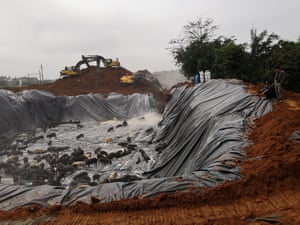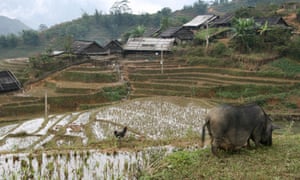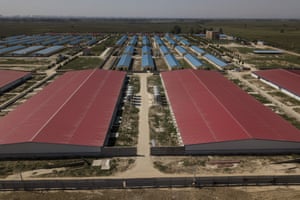Small farmers across the globe are losing out in the aftermath of the African swine fever (ASF) outbreak that killed a quarter of the world’s pig population, argues a new report.
Nowhere is this more evident than China, where swine fever has hit the country’s nearly 40 million small-scale pig farmers hardest, says the report by non-profit organisation Grain.
China’s long tradition of small-scale pig farming seems to be coming to an end because of a lack of government support to compensate for culled or diseased pigs, to pay for veterinary costs or chemicals for limiting the spread of ASF, and other biosecurity measures in existing facilities, according to Grain.
“Unfortunately, small farmers are getting almost no support, from what we can see,” said Devlin Kuyek, lead author of the report.
After the first notification of the ASF outbreak in China in August 2018, the illness spread rapidly throughout the industry and led to the slaughter of millions of pigs within months.
Just a year later, however, the startling rise in pork prices meant that, despite their losses, many of the biggest industrial pig producers were achieving record profits.

Grain has been unable to determine exactly how many of the ASF outbreaks originated in large factory farms or within contract farming production chains that feed the bigger facilities, because of a lack of information or official figures from authorities.
In a MARA survey of 1,500 Chinese pig farms in mid-2019, 55% said they had abandoned plans to raise pigs after culling due to future risk of disease, while 22% were waiting to see if the situation cleared up. Only 18% had definite plans to continue pig farming.
In the 1990s, small backyard farms supplied around 80% of China’s pork needs. But this has changed rapidly over the past two decades, as the government has steadily industrialised the sector. By 2018, the share of pig farms with more than 500 pigs was around 80%, state-run media reported in November. The government is aiming for at least 65% of pork from industrial farming operations by 2025.
As the government’s focus has shifted towards supporting larger-scale production, smaller operations continue to be squeezed into contract farming operations for larger companies.
“It is the combination of these two changes that has created the conditions for the rise of new epidemics [like ASF and others] in Asia’s pork sector,” Kuyek told the Guardian. Despite the fact that it is supposed to be safer, the huge scale of the industrial pig farming industry has propelled the crisis to a global scale, argues the Grain report. “In our view, this is what explains the scale of the recent outbreak. It would not have taken on such massive proportions if it had not penetrated into the global, industrial pork system.”
China is not the only country where small farmers have been particularly adversely affected. In mountainous northern Vietnam, the virus has had a disastrous impact on indigenous women who use leftover mash from rice-wine processing to feed pigs they raise to pay bills and school fees.

Aaron Kingsbury, an assistant professor of Arts and Sciences at Maine Maritime Academy, who was conducting research in the region at the time of the outbreak in Vietnam, witnessed the devastating effects on these small farmers.
“Typically, what you get here is an ethnic minority woman who is raising one or two pigs for family consumption or possibly the wet markets,” Kingsbury said. “Something that provides the family with direct income they otherwise would not have.”
“When one [operation] gets swine fever [and culling begins], the industrial producers are much more capable of tapping into government subsidies for losses of pigs than these small [producers], sometimes illiterate women who may not speak Vietnamese and are isolated in small communities,” he said. “When these small producers lose a pig, they really lose quite a bit.”
The report argues that global meat producers are “using the pandemic that they helped to propagate as a political weapon to consolidate their dominance”.
But Brett Stuart, co-founder of Global AgriTrends, an agriculture consulting firm based in the US, disagrees. “I’m not sure that ASF can be shown as a tool of the big companies,” he said. “The incredible profits now are fuelling small farmer margins as well as large.”
Stuart said: “The problem is that complicated diseases like ASF ultimately benefit those with enough scale to pay on-farm vets and implement feed milling procedures, that help protect herds. So while small farmers face a much more uncertain future, that is not enough evidence in my opinion to indict large farmers.”

Andriy Rozstalnyy, an ASF expert and animal health expert at the UN’s Food and Agriculture Organization (FAO) said the organisation was gathering information to enable a full understanding of ASF transmission.
“We cannot speculate on the role of each production sector in ASF spread or endemicity, because the production systems and value chains are very long and complicated in south-east Asia and in particular in China,” Rozstalnyy said.
“The fragmented and incomplete data does not fully explain the real epidemiological situation in south-east Asia. FAO is working to collect and analyse data to better understand ASF transmission including the role of feed, fomites, pork products in production systems with different biosecurity practices. This understanding is used to assist countries in development of technically sound and feasible control strategies.”
Rozstalnyy said early detection and containment of ASF outbreaks challenges both small and large-scale operators and both sectors need to be vigilant about any risky practices and aware of establishing more bio-secure practices.
“It doesn’t matter if it is a small-scale backyard farmer or workers at a large scale commercial farm, feed supplier, butcher, hunter or international traveller. [They all] need to strictly follow rules and regulations defined by governments to address risks related to ASF.”